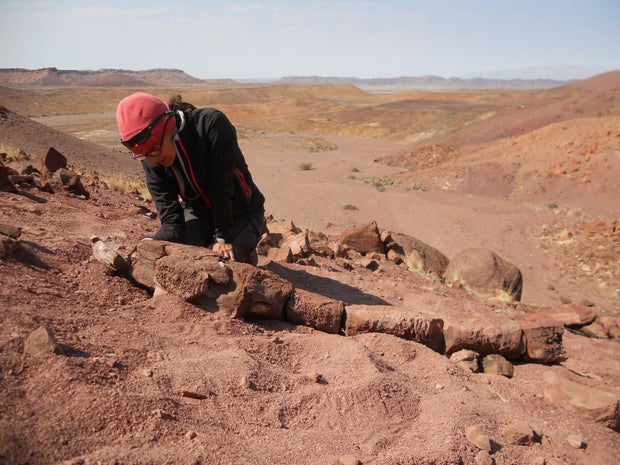Scientists have revealed fossils of an enormous salamander-like beast with sharp fangs that dominated waters earlier than the primary dinosaurs arrived. The animal, researchers say, is roughly 272-million-year-old.
The findings have been revealed Wednesday within the journal Nature. The researchers dubbed the species Gaiasia jennyae, an hommage to Gai-as Formation in Namibia, the place the fossil was discovered, and to Jenny Clack, a paleontologist who studied how vertebrates moved from water to land.
“Gaiasia jennyae was significantly bigger than an individual, and it in all probability frolicked close to the underside of swamps and lakes,” mentioned Jason Pardo, an NSF postdoctoral fellow on the Discipline Museum in Chicago and the co-lead writer of the research, in a information launch.
Credit score: Gabriel Lio
Pardo added that the species had a “huge, flat, rest room seat-shaped head,” “enormous fangs” and “big tooth.”
The predator possible used its broad, flat head and entrance tooth to suck in and chomp unsuspecting prey, researchers mentioned. Its cranium was about 2 ft (60 centimeters) lengthy.
“It is performing like an aggressive stapler,” mentioned Michael Coates, a biologist on the College of Chicago who was not concerned with the work.
Fossil remnants of 4 creatures collected a few decade in the past have been analyzed within the Nature research, together with a partial cranium and spine. The creature existed some 40 million years earlier than dinosaurs developed.
Credit score: Roger M.H. Smith
Whereas Gaiasia jennyae was an aquatic animal, it might transfer on land, albeit slowly. The species belonged to a superclass of animals known as tetrapods: four-legged vertebrates that clambered onto land with fingers as an alternative of fins and developed to amphibians, birds and mammals together with people.
Most early tetrapod fossils hail from scorching, prehistoric coal swamps alongside the equator in what’s now North America and Europe. However these newest remnants, courting again to about 280 million years in the past, have been present in modern-day Namibia, an space in Africa that was as soon as encrusted with glaciers and ice.
The invention of Gaiasia was an enormous victory for paleontologists who proceed to piece collectively how the world was evolving throughout the Permian interval.
“The truth that we discovered Gaiasia within the far south tells us that there was a flourishing ecosystem that might help these very massive predators,” mentioned Pardo. “The extra we glance, we would discover extra solutions about these main animal teams that we care about, just like the ancestors of mammals and fashionable reptiles.”

